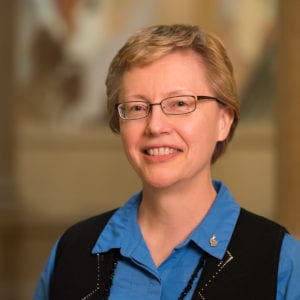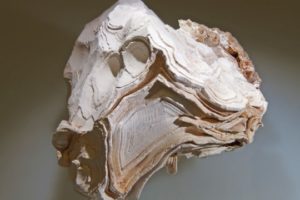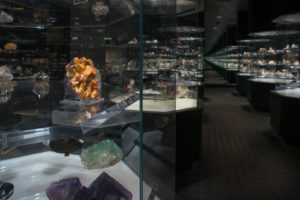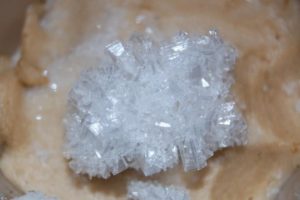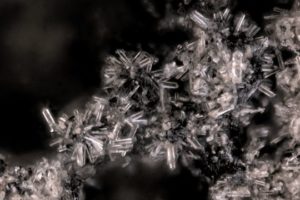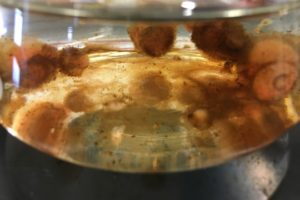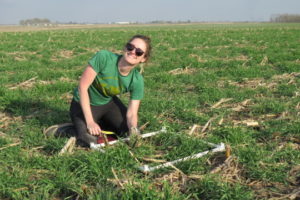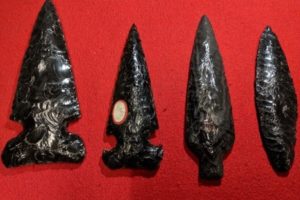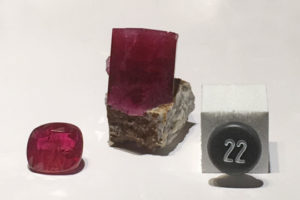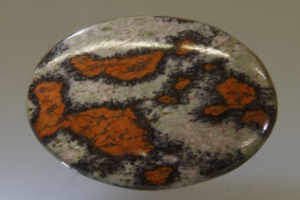
MINERALS (MINERALOGY) AND EARTH SCIENCES AT CARNEGIE MUSEUM OF NATURAL HISTORY
The emphasis of the more than 30,000 specimens that make up the collection is directed largely toward exhibition and education. Approximately one third of all known mineral species are represented, and a number of the specimens are considered among the finest examples in existence. The Section of Minerals (Mineralogy) and Earth Sciences staff are also diligent about upgrading mineral specimens on exhibit in Hillman Hall of Minerals and Gems and bringing specimens of display quality from new mineral discoveries into the exhibits as they become available.
Section of Minerals (Mineralogy) and Earth Sciences Collection Highlights
The Section of Minerals (Mineralogy) and Earth Sciences collection acquisitions include an outstanding suite of minerals from the former Soviet Union, a historically important suite of nearly 5,000 Pennsylvania minerals formerly owned by the Academy of Natural Sciences in Philadelphia, and more than 2,700 Pennsylvania minerals acquired from the Bryon Brookmyer collection. With the Pennsylvania acquisitions, research into the history and importance of minerals and mineral localities in Pennsylvania was initiated. These acquisitions, combined with the nearly 3,000 Pennsylvania specimens already in the collection, make the Section of Minerals collection an important repository of Pennsylvania’s mineral heritage and the most comprehensive Pennsylvania collection in the world. Overall, approximately one third of the minerals in the collection are from Pennsylvania. The section also houses a gem collection of about 2,000 pieces and a modest collection of meteorites.
Section of Minerals (Mineralogy) and Earth Sciences staff are currently in the process of re-cataloging and digitizing the entire mineral collection, which consists of approximately 30,000 specimens. A large portion of specimens date back to the 19th century, which mandates that the species name and locality information be updated in the collection database to include the modern nomenclature and ever-changing geographic names. See the collection online at minerals.carnegiemnh.org.
Section of Minerals (Mineralogy) and Earth Sciences Visits and Loans
Visits must be scheduled in advance due to the Carnegie Museum of Natural History policy that a staff member must be present. Normal visiting hours are Monday through Friday, 7:30 a.m.–3:30 p.m. Please call 412.622.3391 or email WilsonD@carnegiemnh.org to schedule an appointment. The mineral collection is available for examination or study, onsite or by loan, by qualified persons. Prior arrangements must be made by contacting section staff.
Section of Minerals (Mineralogy) and Earth Sciences staff works with local schools and universities by giving tours in Hillman Hall of Minerals and Gems and behind the scenes.
Additional assistance is afforded advanced students for special projects.
Availability of Collections Onsite
The collection shall be available for examination and study by any qualified individual. Requests for access to the collection shall be made by written and/or verbal form to section staff. Contact Debra Wilson with your request.
Final decision as to the nature of a request to use the collection shall be the responsibility of curatorial staff, together with the director of the museum, if necessary. Decisions shall be based upon the use of the collection in furthering the mission of the museum.
The collection of the museum shall be available for examination and study under the normal museum security procedures and other special procedures as established by staff for the protection of the collection.
Loans to Other Members of the Scientific Community
A loan is the temporary physical transfer of material without transfer of ownership. Loans are undertaken by Carnegie Museum of Natural History as a matter of professional courtesy. The policies for onsite use shall apply in determining whether to provide loans to others for use outside museum premises. Generally, objects/specimens from the collection shall be loaned only to other scientific, research, or educational institutions and not to individuals. Requests should include the following information:
the purpose of the loan;
a description of the material requested in as much detail as possible;
where, and under whose responsibility, the specimens will be housed while on loan.
A permanently employed institutional representative who has authority to bind the borrowing institution should be named responsible for the loan. Investigators who are not located at, or affiliated with, an institution can arrange to have specimens sent to a nearby facility as long as a responsible member of that institution is willing to accept responsibility for the specimens, and provided that the specimens remain on the premises of that institution. Specimens requested by students, post-doctoral fellows, or emeritus faculty require endorsement by an appropriate curator or current faculty member with authority to bind the institution, and are considered the direct responsibility of the institution and the endorser. Under exceptional circumstances, loans may be made to individual borrowers without institutional affiliation or sponsorship. Loans from the permanent collection are made for non-commercial purposes.
Some specimens in the collection are not available for loan, including specimens judged too fragile or too environmentally sensitive to travel. In addition to these general policies, the section may make, subject to the approval of the director, special policies for loans of specimens under their care and for the protection of specimens while on loan. Other stipulations subject to all loaned specimens according to the museum’s policies will be disclosed once approval has been issued to the requestor.
History of the Section of Minerals (Mineralogy) and Earth Sciences
One of the first mineralogy exhibits at the museum was produced by Professor Gustave Guttenberg, a curator at the Academy of Art and Science, who loaned his entire personal mineral collection of 550 pieces to the academy. After his death in 1896, the museum purchased these pieces and they became the core of the permanent mineralogical collection.
As early as 1897, the museum accessioned its first world-class mineral specimen—a pseudomorph of hemimorphite after calcite. This Joplin, Missouri specimen was a gift of A. L. Means.
During its first years, the mineral collection expanded principally through gifts. The museum acquired ores and metals representing the industries of the Pittsburgh region—the ores and manufactured products of tin, lead, copper, antimony, and bismuth. Local examples of steel products, specimens of oil-bearing rock and crude petroleum, and of coal, coke, and graphite were also included.
Andrew Carnegie himself added to the growing collection with several gifts, the most important in 1904 when he purchased the extraordinary mineral collection of William W. Jefferis of West Chester, Pennsylvania.
Jefferis had started collecting in 1837 and for 60 years had devoted himself to developing one of the finest private collections in the country at that time. A friend and constant correspondent of noted mineralogists such as George J. Brush, James D. Dana, Isaac Lea, and Benjamin Silliman, Jefferis furnished specimens for illustrations in many mineralogical publications and textbooks, in particular, James D. Dana’s famous System of Mineralogy.
Jefferis’s large collection contained countless calcite, fluorite, and barite specimens from classic English localities as well as particularly fine suites from other European locales and from New York and Pennsylvania. After 1900, important collectors and institutions maneuvered to obtain his collection before it was put on the market, but Andrew Carnegie was not to be denied. In 1904, Carnegie purchased the collection for Carnegie Museum of Natural History for approximately $20,000.
The records show that another institution offered more at the last moment, but Jefferis, a banker, honored his previous agreement with Carnegie. Two boxcars transported the approximately 12,000 specimens by railroad to Pittsburgh. With the acquisition of the Jefferis Collection, the museum attained stature as a mineral museum and repository. In 1906, Jefferis died shortly after having expressed in a letter to George F. Kunz his pleasure and gratification that Carnegie Museum of Natural History had acquired his life’s work.
In 1902, Pittsburgh native John Lester Lewis donated his collection of 2,575 cut gemstones and gem crystals, freshwater pearls, and pearl-bearing shells to the Carnegie Museum of Natural History. The acquisition of these gemstones was Lewis’ “labor of love” for 30 years. These specimens helped build the foundation of the museum’s growing collection and was the first major gemstone donation. Lewis also made six other smaller donations to the museum in 1904, 1906, 1908, and 1910.
Between 1906 and 1908, the prominent Pittsburgh collector Norman Spang donated approximately 100 specimens, one being a 75-pound, perfectly terminated quartz crystal from Switzerland. In 1919, the pioneer of petrographic microscopy in the United States, Dr. M. E. Wadsworth, Dean of the School of Mines at the University of Pittsburgh, gave his collection of rocks to the museum.
Curator History of the Section of Minerals (Mineralogy) and Earth Sciences
Douglas Stewart’s sole position at the museum for many years was as Custodian of Mineralogy. By 1907, Douglas Stewart, custodian of mineralogy at Carnegie Museum of Natural History, had installed exhibit and storage cases allowing 4,500 specimens to be exhibited in a Hall of Mineralogy and 9,000–10,000 specimens to be stored systematically for reference. In 1923, he also became director of the museum, a position he held until he passed away in 1926. For decades after Stewart’s death, responsibility for the mineralogical collection fell to several professional and amateur mineralogists. For years, in a pattern unfortunately familiar to many natural history museums, no need was felt for a separate curator of mineralogy; the mineral collection was administratively grouped with related areas such as geology and paleontology.
In 1927, geology professors Charles R. Fettle of Carnegie Institute of Technology and Henry Leighton of the University of Pittsburgh were appointed honorary curators of the section. In 1937, invertebrate paleontologist I. P. Tolmachoff, PhD, was named acting curator of mineralogy and then curator of geology and mineralogy in 1943. David M. Seaman, an assistant to Tolmachoff, succeeded him 1945–1949 and invertebrate paleontologist E. R. Eller followed Seaman until 1969. During these four decades, the collection developed very slowly, with the addition of specimens acquired through field collecting, trading, and purchase.
Although upgrading the exhibit specimens and the gallery space, the Mineral Exhibition Hall, had been the primary focus during Seaman’s tenure in the 1940s, his successor dismantled the exhibit hall in the early 1950s and most of the specimens were placed in storage. A decade later, under the same curator, the collection’s emphasis shifted back to the acquisition of exhibit-quality specimens as well as gem materials. Some specimens were placed on public exhibit. In the latter part of the 1960s, geologist Delbert L. Oswald, working as a research associate under Eller’s guidance, assisted in the development of a small exhibit of minerals.
In 1969, then President of Carnegie Institute, James M. Walton, spoke with one of Pittsburgh’s most prominent businessmen, Henry L. Hillman, about the early stages of a capital campaign fund. The discussion centered on the steps to be taken to upgrade the existing exhibits and the program areas where new exhibits could be introduced to enhance Carnegie Museum of Natural History.
When Walton approached Hillman, a trustee of the museum from Pittsburgh who earned a degree in geology from Princeton, Hillman recalled that he had gone to see a commercial display of minerals that was presented at a Pittsburgh department store, and he was impressed by the number of people who were attracted to and fascinated by the mineral specimens. With this experience in mind, he expressed to Walton an interest in supporting a new mineral exhibit designed to present “minerals in the manner of sculpture and shown for their beauty as well as physical properties and economic uses.”
For the next decade, the generosity of Henry L. Hillman and The Hillman Foundation, Inc., made it possible for Carnegie Museum of Natural History to acquire exhibit-quality specimens for a new hall to be built.
Delbert Oswald was working in the mineral section at that time and became associate curator, devoting his full attention to enhancing the mineral exhibit collection and developing the hall. In the early 1970s, during the first few years of this effort, the noted mineralogist Dr. Frederick H. Pough was retained as a consultant to assist Oswald.
The mineral section of the museum became increasingly active and gradually took on a new autonomy within the museum. Not only did The Hillman Foundation provide funds through a capital fund grant for the renovation of space allocated to the new mineral hall, it also provided funds for a specimen acquisition program. A masterpiece pegmatite assemblage from the Little Three Mine in California and a 70-gram platinum nugget from the Soviet Union were purchased at this time, in addition to what is very likely the world’s largest single crystal of rutile, a 24-pound mirror-faced specimen from Graves Mountain, Georgia.
Supported by The Hillman Foundation, the museum acquired a 19-piece gold collection from the Harvard Mineralogical Museum and the Dr. Frederick H. Pough gem collection of nearly 800 specimens. The Pough Gem Collection represents more than 30 years of personal selection, half of which is comprised of rare and highly unusual gem species. Many of the gems currently on display in Wertz Gallery are from the Pough Collection.
Along with the increase in purchased accessions, the mineral section witnessed an increase in donor interest, which brought in many new specimens suitable for exhibition in the mineral and gem hall. The J. Allen Thiel and J. P. Gills Rough and Cut gem collections were donated as were the collection’s finest Brazilian aquamarine crystal and its finest bejeweled aquamarine and diamond brooch.
After 11 years of specimen acquisition, planning, and construction, Hillman Hall of Minerals and Gems opened in September, 1980. The concept of presenting mineral specimens as sculptures was adhered to, and the beautifully designed exhibit hall provides a basic understanding and appreciation of minerals—scientifically, educationally, and aesthetically.
Oswald retired from the museum shortly thereafter, and for several years the mineral section and the exhibit hall were directly under the auspices of Mary R. Dawson, PhD, Vertebrate Paleontologist and Chief Curator of Earth Sciences. In 1982, geologist Richard A. Souza was hired to oversee the mineral section’s exhibition and education programs and the management of some 23,000 specimens. During the eight years that followed, Collection Manager Souza worked closely with Ronald W. Wertz, President of The Hillman Foundation, to develop one of the most active and successful specimen acquisition programs of any major natural history museum in North America. The goal was to acquire some of the world’s finest specimens in a variety of species while also filling in species and locality voids and significantly upgrading the other species on exhibit.
In 1987, The Hillman Foundation worked with Carnegie Museum of Natural History to establish The Carnegie Mineralogical Award. This national award is given annually at the Tucson Gem and Mineral Show to an honored recipient in recognition of outstanding contributions that have promoted mineralogical preservation, conservation, and education—the ideals embodied in Hillman Hall of Minerals and Gems.
Numerous grants have revitalized the mineral section’s programs. In 1988, Carnegie Institute President Dr. Robert C. Wilburn and the Trustees launched the Second Century Fund campaign with a goal of $125 million. As part of its contribution to this fund, The Hillman Foundation established an endowment for Hillman Hall of Minerals and Gems to provide for continuing improvement of and operating support for the mineral program. This contribution also provided funding for a mineral conservation and preservation laboratory and a permanent curatorial position.
Also that year, portions of all eight meteorites ever found in Pennsylvania were displayed for the first time in Hillman Hall.
In 1992, Marc Wilson took over the management of Hillman Hall, and during his 25-year tenure, the museum’s mineral collection grew, new exhibits were developed, and the hall saw many improvements. The first improvements Marc did were a complete makeover of the Pennsylvania exhibit and the addition of an amber exhibit. In 1996 Marc introduced the exhibit Pseudomorphism in Minerals, and in 1997 added the Minerals of the Former Soviet Union exhibit with minerals that became available after Communism collapsed. The year 1999 saw the installation of the Micromineral exhibit and in 2000 two more exhibits, Fluorescent and Phosphorescent Minerals and the Twinning in Minerals exhibit.
Exhibits continued to grow during the past two decades under the leadership of Marc, who has done everything from specimen management to investigating minerals at active and abandoned mine sites. In 2006, Marc – who was inducted into the National Rockhound and Lapidary Hall of Fame in 2001 – oversaw the renovation and expansion of Hillman Hall, which re-opened in 2007. The renovated hall now has a beautiful new entrance to greet visitors, Masterpiece Gallery and the Systematic Collection have been expanded, locality suites from England, Romania, India and Bulgaria were added as well as an exhibit of Mineral Slices. The new addition to the hall, Wertz Gallery: Gems and Jewelry, includes a stunning Birthstones exhibit.
Meanwhile, during his era, Marc’s wife, Debra, had been working at the museum and preparing for her future leadership role. When the couple arrived in the Pittsburgh area in 1992 for Marc’s new job, Debra Wilson initially worked as a volunteer, and then became a paid Collection Assistant. After Marc retired from his position, Debra took over the role of Collections Manager in August 2017. She has a passion for photographing minerals, and has seen many of her photos published in books, magazines, newspapers and other media. In 2019, Carla Rosenfeld, PhD., was hired as Assistant Curator of Earth Sciences, and Travis Olds, PhD., was hired as Assistant Curator of Minerals (Mineralogy).
Section of Minerals Collection Featured in Museum Displays
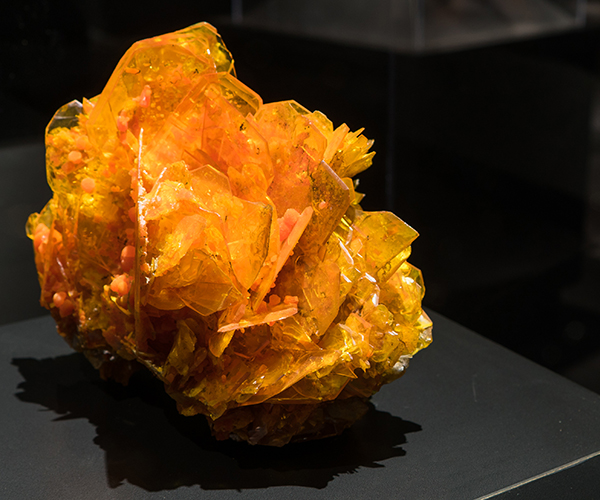
Hillman Hall of Minerals and Gems showcases more than 1,300 minerals and gems from all over the world and has gained an international reputation as one of the finest and most important mineral exhibitions in the world. New acquisitions are added to the collection on an ongoing basis. This breathtaking exhibition hall is the culmination of the science, beauty, and history of minerals. See more of this amazing hall in the Hillman Hall of Minerals and Gems online exhibit.
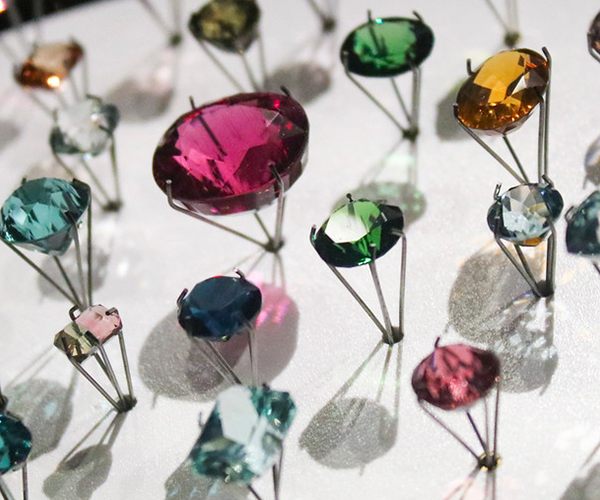
Wertz Gallery: Gems & Jewelry is a 2,000-square-foot addition to Hillman Hall of Minerals and Gems dedicated to gems, the crystals from which they come, and jewelry comprised of these precious stones. Wertz Gallery is named in honor of Ronald W. Wertz, longtime president of the Hillman Foundation. Over 500 gems, crystals, pieces of jewelry and other gem art are on display in the permanent collection of Wertz Gallery including the stunning Birthstones exhibit. In addition, Wertz Gallery hosts special temporary and traveling exhibitions from around the world.
Carnegie Mineralogical Award
The Carnegie Mineralogical Award honors outstanding individuals or groups whose contributions in mineralogical preservation, conservation, and education match the ideals advanced in Carnegie Museum of Natural History Hillman Hall of Minerals and Gems. Established in 1987 through the generosity of The Hillman Foundation Inc., the award consists of a bronze medallion, a certificate of recognition, and a $3,000 cash prize. The award is presented each February during the Tucson Gem and Mineral Show.
The annual deadline for nominations is November 15. Mineral enthusiasts, collectors, educators, curators, mineral clubs, societies, museums, universities, and publications are eligible. See below for a list of present and past winners.
Download the Carnegie Mineralogical Award Nomination Form (Word Document).
2023 Carnegie Mineralogical Award Winner
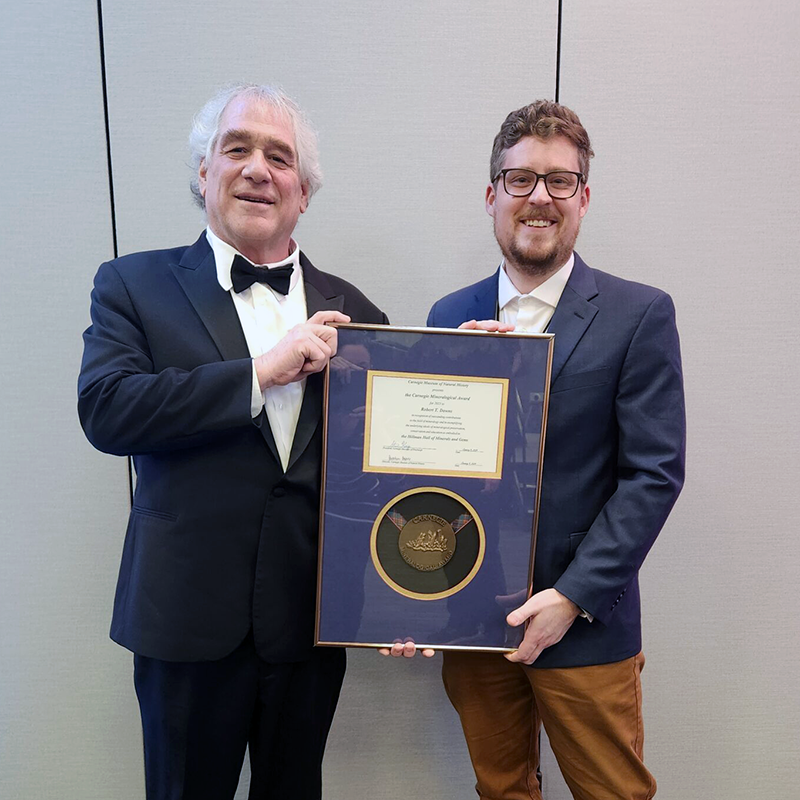
Previous Winners
2022 Willliam B. “Skip” Simmons, Jr., PhD.
2021 Barbara L. Dutrow, PhD.
2020 John C. Medici, PhD.
2019 John F. Rakovan, PhD.
2018 Dudley P. Blauwet
2017 W. Lesley Presmyk
2016 Anthony R. Kampf, PhD.
2015 George Harlow, PhD.
2014 Bryon N. Brookmyer
2013 Gloria A. Staebler
2012 George W. Robinson, PhD.
2011 Jeffrey E. Post, PhD.
2010 The Rochester Mineralogical Symposium
2009 Peter K.M. Megaw, PhD.
2008 Frank C. Hawthorne, PhD.
2007 Jeffrey A Scovil
2006 Richard C. Whiteman
2005 June Culp Zeitner
2004 Joel A. Bartsch, PhD.
2003 Eugene S. Meieran, ScD.
2002 Terry C. Wallace, Jr., PhD.
2001 Wendell E. Wilson, PhD.
2000 F. John Barlow, ScD.
1999 Sterling Hill Mining Museum
1998 Robert W. Jones
1997 Bryan K. Lees
1996 Cornelis (Kase) Klein, PhD.
1995 Marie E. Huizing
1994 The Mineralogical Record
1993 Cornelius S. Hurlbut, Jr., PhD.
1992 Carl A. Francis, PhD.
1991 Miguel A. Romero Sanchez, PhD.
1990 Paul E. Desautels
1989 Frederick H. Pough, PhD.
1988 John Sinkankas, DHL.
1987 The Tucson Gem & Mineral Society
Mineral Blogs

Thanksgiving and Nutritional Mineralogy
by Travis Olds We each have plenty to be thankful and hopeful for this year, but did you know that our traditional …
Meet our two new curators!
Dr. Travis Olds Hello! My name is Travis Olds. I’m Assistant Curator of Minerals in the Section of Minerals and Earth Sciences …
The Mineralogy of Ice Cream
by Travis Olds Have you ever made ice cream at home? You may have noticed that homemade ice cream has a different …
What Do Minerals and Drinking Water Have to Do With Each Other?
In the same way scientists discover new plant or animal species, new minerals are usually found by exploring new places with hard …
Fungi make minerals and clean polluted water along the way!
Fungi are all around in the environment. For example, the mold that invades wet basements, the mushrooms that we cook with, and …
A Rare New Species for Natural History: Earth System Scientists
Part of Anthropocene science is earth system science, the study of anthropogenic change of whole earth systems–the water systems, geological systems, ecosystems, …
“Minecraft™ Lied to Me!?”
On October 19, 2019, the Section of Anthropology once again had the pleasure of assisting the Education and Interpreter staff in awarding …
Roll Out the Beryl
Beryl has many different varieties that you may be familiar with, the most recognized being: Emerald (green), Heliodor (yellow), Morganite (pink), and …
Everything Pennsylvania
On May 10th a new temporary exhibit is scheduled to be installed in Wertz Gallery: Gems and Jewelry that will feature gemstones, cabochons, …

